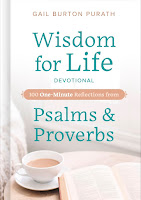In The Christmas Tree, I talked about the most important way Christmas trees symbolize Christ's coming. But there are other ways we can use the symbolism as well:
1. Evergreen trees, a symbol of a productive, ever-green faith.
Jeremiah 17:7-8: "Blessed is the one who trusts in the LORD, whose confidence is in him. They will be like a tree planted by the water that sends out its roots by the stream. It does not fear when heat comes; its leaves are always green. It has no worries in a year of drought and never fails to bear fruit."(1)
You might also enjoy reading Exploring God's Message in the Color Green.
2. A symbol of a longing fulfilled when Christ came to save us.
Proverbs 13:12: "Hope deferred makes the heart sick, but a longing fulfilled is a tree of life."
3. A symbol of gracious words.
Proverbs 15:17: "Gentle words are a tree of life; a deceitful tongue crushes the spirit."
4. A symbol of a righteous life in Christ.
Proverbs 11:30: "The fruit of the righteous is a tree of life, and the one who is wise saves lives."
5. The best symbolism is still the tree of life.
The restoration of our ability to eat from the tree of life and spend eternity with the Lord (Genesis 2:9; Genesis 3:22; Revelation 2:7; Revelation 22:14; Revelation 22:1-5).
Note: If you have concerns about Christmas trees, don’t use one. I don’t want to persuade anyone to use a tree against their conscience (Romans 14).
But for those who have questions and haven’t made up your minds, please realize that just because ancient pagans decorated their homes with greenery, that doesn't make the practice evil.
Pagans pray to false gods, but that doesn’t make prayer evil. God created trees for our pleasure and enjoyment, and His Word is full of rich symbolism using trees.
We call them "Christmas" trees—they don't have a pagan name, and we don't use them to mimic pagan rituals. If any aspect of the Christmas tree had pagan roots (which isn't verified), it lost that meaning hundreds of years ago.
People who oppose Christmas and Christmas trees usually claim the practice originated in the pagan festival of Saturnalia. However, if you study that festival carefully, you will find that they decorated trees outside with symbols of the sun god and only brought branches and greenery into their homes. In addition, this pagan holiday was celebrated on December 17th, not the 25th.
Other people claim that Christmas mimics the holiday of Winter Solstice, which was called “the Yule” in Germanic countries. It’s true that they felt the evergreen tree was a symbol of life in the winter, but they didn’t cut trees down and bring them inside to decorate.
There is also a widely held belief that Martin Luther began the practice of decorating trees with candles at Christmas time.
We can’t prove this Luther connection, nor can we prove the pagan connections.
Is it possible that the Christmas tree is loosely related to some pagan practice? It’s possible. Is it possible that the Christmas tree tradition originated with Luther? It's possible.
We need to ask ourselves what the tree symbolizes for us when we put it in our living room. If a person associates it with its pagan roots, they are honoring God by not having a tree. If we associate it with its Christian roots, we are honoring God by having one.
These articles offer more details:
The Anti-Christmas Spirit
Should we have a Christmas tree?
Do Christmas Trees Have Pagan Roots?
Bible Love Notes





Do you or anyone you know post a brief daily devotional for children ? I have an 11 year old boy in mind And as he is a new Christian I would love to have this type of resource to share with him .
ReplyDeleteI'm sorry, Leah, I don't know any site I could personally recommend. I have lots of blogger friends who I'd recommend, but they don't have children's sites. But I think it's a great idea!
Delete